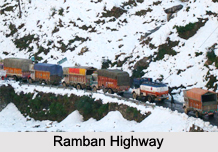 Ramban is a town in the Ramban district in Indian state of Jammu and Kashmir.
Ramban is a town in the Ramban district in Indian state of Jammu and Kashmir.
Location of Ramban
Ramban, now the city and the headquarter of the newly formed Ramban District of Jammu and Kashmir, is originally located in the south of Anantnag district.
Geography of Ramban
Ramban is the district headquarters. Ramban town is located on the right bank of Chenab river, on the National Highway-1A (now NH44) at about 150 km from Jammu and about 150 km from Srinagar, making it almost the central point on the Jammu-Srinagar National Highway.
Landforms of Ramban
Ramban and the district of Ramban have an average elevation of 1,156 metres (3792 feet). The boundary lines of Ramban district have come to be drawn from Patnitop on its south, Assar on its east, Gool on its west and Banihal on its north. Ramban district comprises two Tehsils, namely, Ramban and Banihal, and four community development blocks, namely, Banihal, Gool, Ramban and Ramsoo.
Villages in Ramban
Ramban consisted of 116 census villages and 127 Revenue villages in 2001. Total panchayat Halqas in District Ramban are 124.
Demography of Ramban
Ramban town had a population of 8,128. Males constitute 68 percent and females 32 percent of the population. Ramban had average literacy rate of 77%, higher than the Indian national average of 59.5%. Male literacy was 86%, and Female literacy was 59%. In Ramban, 10% of the population is under 6 years of age.
This article is a stub. You can enrich by adding more information to it. Send your Write Up to content@indianetzone.com
Related Articles
Cities of Jammu and Kashmir
Culture of Jammu and Kashmir
Jammu and Kashmir, Indian State
Costumes of Jammu and Kashmir
Ramban District
Srinagar



















